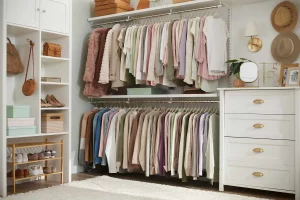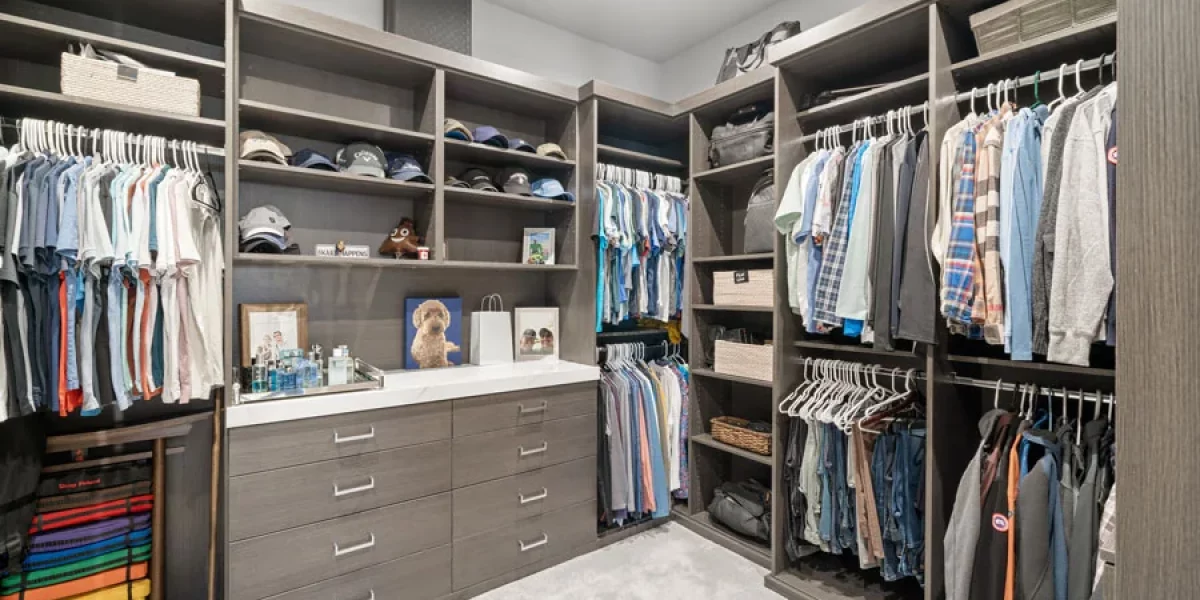Designing a custom closet requires balancing form and function. It’s not just about maximizing storage space; a well-designed closet reflects your brand’s image, setting a cohesive tone. How to design a custom closet involves defining your objectives and evaluating your closet space. This approach creates a space that efficiently stores belongings and elevates your brand’s image. Prioritize key elements to achieve this goal.
Key elements to prioritize include defining your objectives, evaluating your closet space, and striking a balance between form and function. When designing a custom closet, consider the impact on your brand’s image. A well-designed closet not only efficiently stores belongings but also elevates your brand’s image.
Key Takeaways
- Define personal style and brand image objectives to guide the custom closet design process.
- Assess closet space and needs by taking precise measurements and evaluating lifestyle habits.
- Choose elevated storage and shelving solutions to optimize vertical space and maintain organization.
- Incorporate brand aesthetic elements, such as custom cabinetry and branded accessories, for a cohesive look.
- Maximize closet space efficiently by thinking vertically, using door storage, and implementing custom islands or built-in dressers.
Defining Custom Closet Objectives
A well-crafted custom closet is not just a storage space, but an extension of one’s personal style and a reflection of their brand’s image. When it comes to designing a custom closet, defining objectives is vital to creating a space that not only maximizes storage but also enhances one’s brand. To achieve this, individuals must consider their personal style, lifestyle, and preferences.
Consider the type of clothing and accessories that will be stored, as well as the desired ambiance and aesthetic of the space. For instance, a fashion-forward individual may prioritize a sleek, modern design with ample storage for shoes and handbags, while a busy professional may require a more functional layout with easy access to everyday essentials.
Ultimately, how to design a custom closet that effectively meets one’s needs requires a clear understanding of these objectives. By defining these goals, individuals can create a custom closet that not only maximizes space but also reflects their unique style and enhances their brand’s image. A well-designed custom closet can elevate one’s lifestyle and contribute to a sense of belonging and success.
Assessing Closet Space and Needs
Defining objectives for a custom closet design sets the stage for a functional and stylish space. Now that you have a clear understanding of what you want to achieve with your custom closet, it’s time to evaluate the space and your needs. Evaluating closet space and needs is a critical step in the design process, as it helps you determine the best use of the available space and verify that your custom closet meets your requirements.
To evaluate your closet space, start by taking precise measurements of the area, including the dimensions of the room, doorways, and any windows or obstructions. Consider the natural light, electrical outlets, and plumbing fixtures, as these can impact the design and functionality of your custom closet. Think about your lifestyle and how you use your closet. Do you have a lot of shoes, accessories, or out-of-season clothing that need to be stored? What type of activities will you be doing in your closet, such as getting dressed or doing laundry? By understanding your needs and the space, you can create a custom closet that is tailored to your specific requirements and enhances your brand’s image, especially when learning how to design a custom closet.

Choosing Storage and Shelving
Elevated storage and shelving solutions play a pivotal role in transforming a custom closet from a cluttered space to a serene oasis. When it comes to choosing storage and shelving for your custom closet, consider the specific needs and preferences you identified in the assessment phase of how to design a custom closet. Double-hang rods, triple-hang rods, or adjustable hanging rods can optimize vertical space and accommodate varying garment lengths. For folded items, consider installing shelves or drawers with dividers to maintain organization and prevent clutter buildup.
To maximize storage capacity, incorporate shelves with baskets or bins that can be easily accessed and labeled. Drawers with soft-close glides and organizers can provide a seamless storage solution for delicate or frequently used items. Adjustable shelves and modular storage units can be customized to fit your unique needs, ensuring a tailored storage solution that enhances the overall functionality of your custom closet. By thoughtfully selecting storage and shelving solutions, you can create a harmonious balance between form and function in your custom closet.
Incorporating Brand Aesthetic Elements
The carefully curated aesthetic of your custom closet should serve as a seamless extension of your brand’s image, reflecting the values and style that set your business apart. When it comes to how to design a custom closet, incorporating brand aesthetic elements is vital in creating a cohesive and recognizable space. This can be achieved by incorporating elements that mirror your brand’s visual identity, such as color schemes, typography, and patterns.
To effectively incorporate brand aesthetic elements into your custom closet design, consider the following ideas:
- Custom Cabinetry: Design custom cabinetry that reflects your brand’s style, using materials and finishes that align with your brand’s aesthetic.
- Branded Accessories: Incorporate branded accessories, such as custom knobs or pulls, to add a touch of personality to your closet design.
- Color Scheme: Choose a color scheme that mirrors your brand’s colors, creating a cohesive and recognizable space that reflects your brand’s image.
Maximizing Closet Space Efficiently
When designing a custom closet, crucial to think vertically. Use floor-to-ceiling storage units or shelves to make the most of the available space. Consider installing a pegboard or a hook system on the back of a door to hang belts, hats, or bags. This will not only save space but also create a visually appealing display.
To further enhance space efficiency, consider incorporating a custom island or a built-in dresser. These features can provide additional storage and counter space, creating a functional and stylish closet that reflects your brand’s image. By implementing these design elements, you can create a custom closet that maximizes space and enhances your brand’s aesthetic, making it a vital aspect of how to design a custom closet that maximizes space and style.
Frequently Asked Questions
Can a Custom Closet Be Designed for a Small Budget?
Designing on a small budget is feasible with strategic planning. Assess existing space, prioritize needs, and allocate resources efficiently to create a functional, stylish custom closet that meets your specific requirements and aesthetic goals.
How to Maintain a Custom Closet’s Organization System?
To maintain a custom closet’s organization system, implement a ‘home for everything’ approach, utilizing labels and dividers to categorize items, ensuring easy access and visibility, while promoting a sense of serenity and belonging within the space.
Are Custom Closet Designs Suitable for Rental Properties?
For rental properties, custom closet designs can be a viable option, as they can be tailored to fit specific space constraints and provide a unique touch, potentially increasing the property’s appeal to renters and retention rates.
Can a Custom Closet Be Designed for Multiple Users?
Shared closets can be harmonious sanctuaries, fostering unity and belonging. Designing a custom closet for multiple users requires thoughtful consideration of individual needs, integrating personalized storage solutions, and maximizing communal space to promote a sense of togetherness.
Do Custom Closet Designs Require Professional Installation?
While not always necessary, hiring a professional for custom closet installation is recommended to guarantee precise measurements, efficient use of space, and seamless integration with existing design elements, resulting in a flawlessly executed, bespoke storage solution.
Conclusion
A well-designed custom closet seamlessly integrates functionality and aesthetics, elevating a brand’s image. By marrying precision and creativity, the space is optimized to reflect the brand’s unique identity. With careful consideration of vertical space, clever storage solutions, and bespoke elements, the custom closet becomes a monument to thoughtful design. Ultimately, this harmonious blend of form and function yields a stylish, efficient, and highly effective closet space that showcases a brand’s distinct character.
You May Also Like To Read:
